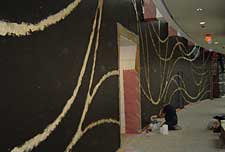Art
on the Courthouse Wall
A work in progress:

Sol LeWitt's original scale
version of "Wall Drawing #1259 Loopy Doopy." |

Artists from Smith and other area colleges stood on
scaffolding throughout the day. |

The artists first applied tape to mirror the drawing's
contours. |

Gallons of black paint fill in between the lines, which
were finally painted white. |
| Sol LeWitt in the Smith College Museum of Art |
After a month during which artists
worked full-time six days a week, applying multiple coats
of paint according to specific
instructions, the
U.S. Federal Courthouse in Springfield, Mass., has a new
mural on a third-floor interior wall.
Following a set of instructions and drawing created by the
late artist Sol LeWitt, a leader in conceptual art, Carl
Caivano, a visiting lecturer in the art department, joined
four Smith students and an alumna, as well as three other
Five College students, in painting the mural in the recently
built courthouse, located at 300 State St.
The black-and-white work,
titled “Wall Drawing #1259
Loopy Doopy,” is the last piece commissioned by LeWitt
before his death last year. The finished mural measures 230
feet wide by 19 feet high.
“The drawing by Sol LeWitt was specific and only modified
slightly to make all the lines flow as he would have wanted,” said
Caivano. “His instructions were to make any changes
necessary to keep the whole thing fluid.”
Like LeWitt’s “Wall Drawing #139,” which
was installed at the Smith College Museum of Art in January,
the courthouse mural existed only as a series of instructions,
along with a small-scale drawing, until it was painted.
“LeWitt believed that the idea behind a work of art
is more important than its execution,” explained Aprile
Gallant, curator of prints, drawings and photos at the Museum
of Art. “To that end, the artist created many works
that took the form of detailed instructions that could be
completed by anyone and at any time in any place.”
“Wall Drawing #139” was installed by Roland
Lusk, a draftsman from LeWitt’s New York studio, with
the assistance of three Smith students.
Caivano and the Springfield
group of artists began following LeWitt’s instructions
on February 18, preparing the courthouse wall, attaching
string along the space in a specified grid pattern, drawing
lines and applying tape.
Then came the paint—more
than 20 gallons of it by the time it was finished. After
five coats of black paint and four gallons of white to
create lines, the piece was completed this week.
“As an artist, having a work by a major figure in
the conceptual art movement on a courthouse in Springfield
is significant,” commented Caivano, “from a cultural
standpoint but also from a civic standpoint, in that people
who use the building will be interacting with a very vivid,
arresting and unexpected image.”
As might be expected,
the mural attracted the attention of people working in
and frequenting the building, Caivano said. “There have been several tours by judges, lawyers,
government people and the media,” he said. “The
construction workers have been interested and seem to have
changed from mildly curious to supportive. The response has
been very positive.”
Though Caivano and his fellow artists had detailed instructions
and a scale drawing to follow, the work was not always easy,
he said. He and the students typically worked in shifts from
9 a.m. to 4 p.m., often standing for hours at a time on scaffolding
up to 19 feet off the ground, navigating constant challenges
with the work space.
It’s all in the
name of art, and in the case of the Springfield Courthouse,
for a final public tribute to an artist that repeatedly
broke new ground while deflecting attention away from his
own celebrity.
“For all of our difficulties, including working high
up with a difficult site, our crew is very excited by the
results,” Caivano said.
|























